G4 Ultralight Pack
Introduction
This pack began as an experiment to see how light I could make a pack. It is highly specialized to the way my main hiking buddy Read Miller and I hike and the gear we carry. It is designed to carry loads of 20 – 30 lbs. It is based on the first three packs I made, which have been used for 3 seasons and hundreds of trail miles. Read had a number of requests. One was that the pack be light. He likes to carry a Platypus with a drinking hose, so he wanted an outside side pocket where the water can hang upside down for ease of drinking, but be visible in case it leaks. Our sleeping pads are Z-Rest pads that are cut down to 6 sections and trimmed to 15” wide. Read wanted to be able to sit on his pad while he packed his pack, then put the pad onto the pack for back padding. He likes to take a slightly larger sleeping bag for some winter trips, so the bottom of the pack is larger for that purpose. He wanted a spot that he could shove something to dry out without worrying that it would slip from under a strap and drop unnoticed to the trail. He likes a waist belt to help secure the pack and distribute the weight.
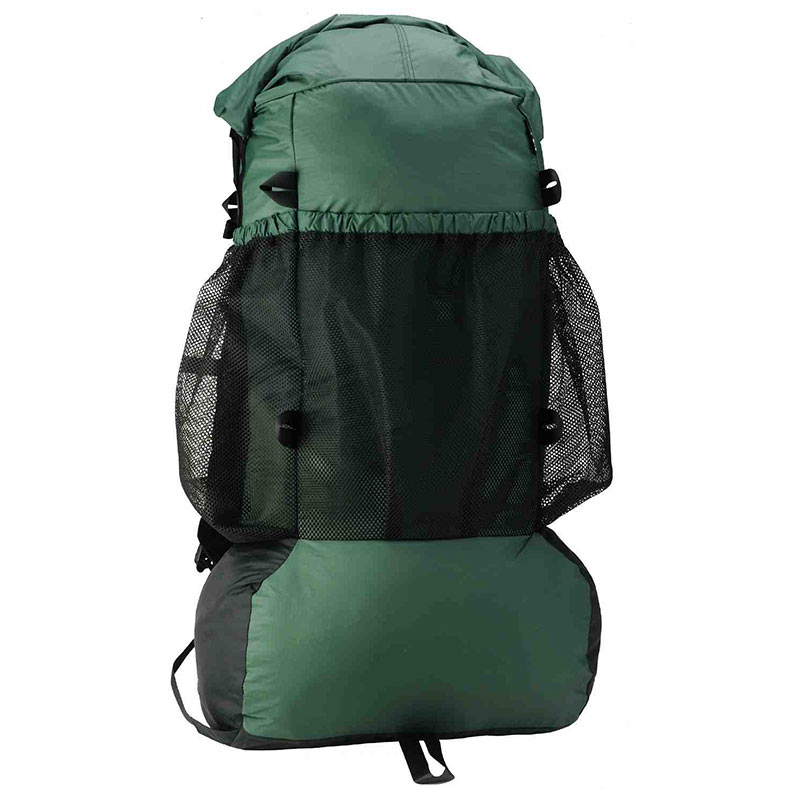
Features
- Weight: 12 oz. (depending on how short you trim straps, how big your waist is, etc.)
- Capacity: 4400+ cu. in.
- Deep mesh side pockets for water and quick-access items
- Mesh back pocket for drying items
- Waist belt included
- Material cost: approx. $30
Material List (first number is Quest Outfitters item no. 800/ 359-6931)
| 1013 | 200 denier coated oxford | 1 yd. |
| 1014 | 2.2 oz. coated ripstop nylon | 1 yd. |
| 1209 | Lycra micro mesh | 1/6 yd. |
| 1201 | Poly mesh | 1/2 yd. |
| 2030 | 1” nylon webbing (lt. wt.) | 2 2/3 yd. |
| 2031 | ¾” Grosgrain ribbon | 2 2/3 yd. |
| 2402 | 3/32” shock cord | 4 yd. |
| 3010 | 1” ladderlock buckles | 2 ea. |
| 3067 | 1” Dual side release buckle | 1 ea. |
| 2600 | thread (120 yd. spool) | 3 ea. |
| 3059 | elliptical toggle | 1 ea. |
| 2100 | ¾” Hook (like Velcro) | 1/3 yd. |
| 2101 | ¾” Loop (like Velcro) | 1/3 yd. |
For optional roll-top closure (a better system) instead of slide top closure, order…
| 2100 | ¾” Hook | 1/3 yd. more |
| 2101 | ¾” Loop | 1/3 yd. more |
| 2402 | Shock cord | 1 ½ yds. less |
| 1014 | 2.2 oz. coated ripstop nylon | 1/3 yd. less |
| 2031 | ¾” Grosgrain ribbon | 1/3 yd. more |
Other substitutions you may want to consider…
Substitute 1044 330 Denier Codura for the oxford cloth – the cordura is a little heavier, but has a higher thread count and is a little more durable.
For solid side pockets if you travel through brush a lot, order an additional 1/3 yd. of ripstop.
For lighter mesh, order the 1207 Mesh Lining for use in pockets. Some people have had troubles with brush ripping holes in the pockets, but others have used their packs for hundreds of miles with little or no damage. Put a small panel of ripstop in the bottom.
For a lighter pack, you could use 1024 1.1 oz. silicon-coated nylon in place of the 2.2 oz. ripstop. The 1.1 oz. usually has more limited color availability, and is much more difficult to work with because it is do darned slippery. It is not recommended for your first attempt.
Note: all seams ½” unless noted otherwise. Some basic sewing experience is assumed. Keep track of the coated (“wrong” or inside) and uncoated (“right” or outside) sides of the fabric.
Step 1: Cutting Materials
1.1 Cut out all fabric pieces according to Figures 1A, 1B and 1C. Be careful on the side bottoms to cut one right and one left. A rotary cutter is very useful. Note that this pack is made for a medium-height to tall man. Some modifications of the dimensions may be indicated for people over 6’4” or shorter than 5’8”.
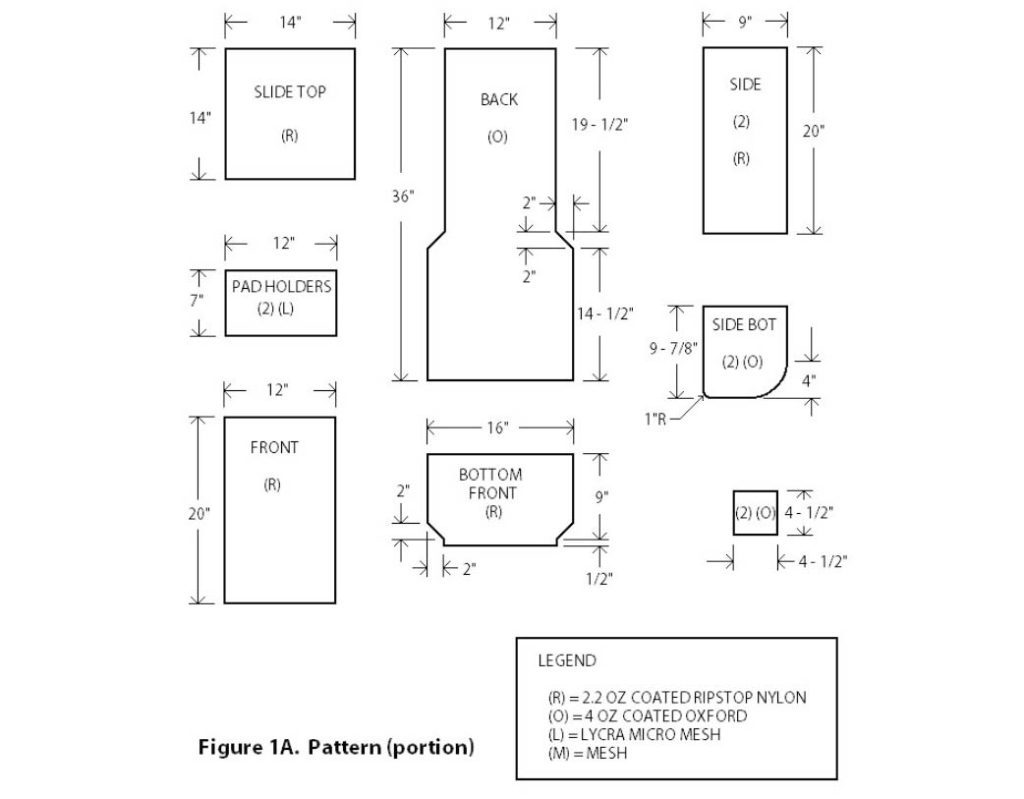
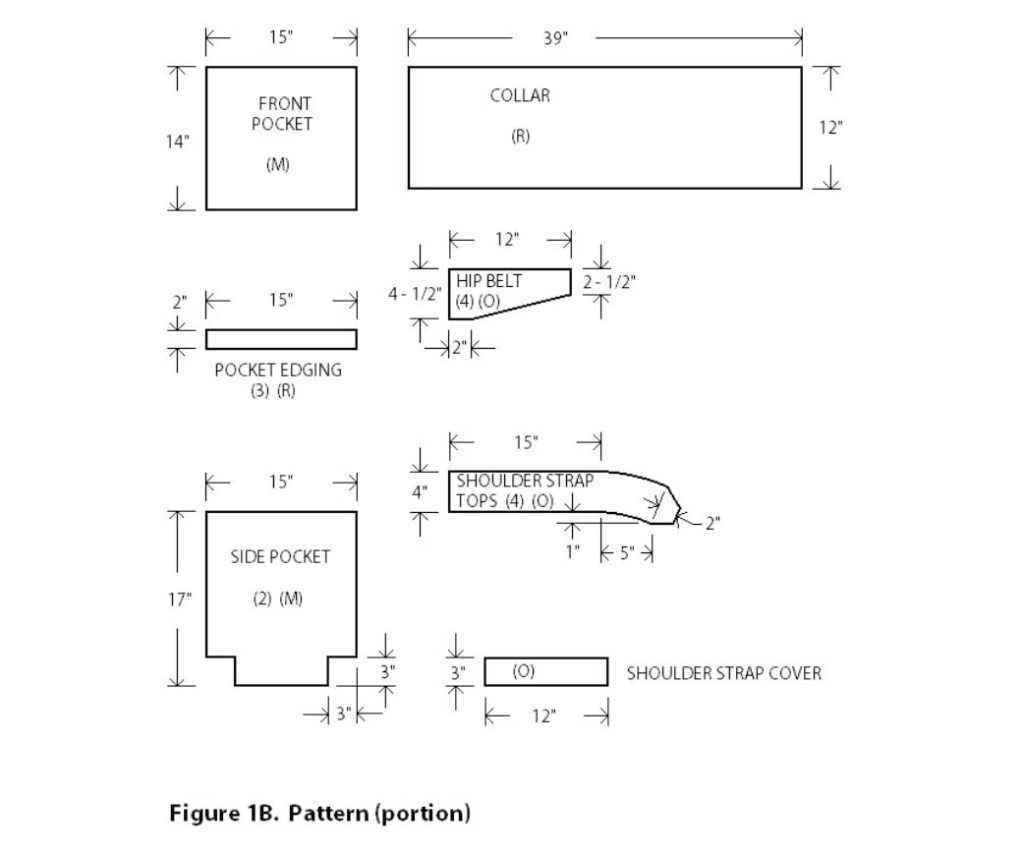

1.2 Cut out webbing pieces as follows and sear all ends with a flame:
1 – 10” piece of 1” webbing (haul loop)
2 – 5” pieces of 1” webbing (shoulder strap tops)
2 – 18” pieces 1” webbing (waist belt)
2 – 20” pieces 1”webbing (shoulder strap bottoms)
8 – 3½” pieces ¾” Grosgrain (side lashing loops)
1 – 10” piece ¾” Grosgrain (bottom lashing/ice axe loop)
4 – 4” pieces ¾” Grosgrain (drinking tube holders, if desired)
2 – 5” pieces ¾” Grosgrain (optional roll-top closures)
2 – 6” pieces ¾” Grosgrain (thumb loops, if desired)
1 – 12” piece ¾” Grosgrain (top pad holder)
1 – 16” piece ¾” Grosgrain (bottom pad holder)
1.3 Cut out shock cord pieces as follows:
3 – 18” pieces (top of pockets)
1 – 48” piece (drawcord for main compartment)
2 – 24” pieces (slide top)
1.4 Cut hook and loop pieces as follows:
1 – 7” piece hook and loop (cut in half lengthwise to make 2 pieces 3/8” wide)
1 – 5” piece hook and loop (cut in half lengthwise to make 2 pieces 3/8” wide)
for optional roll-top closure, cut:
2 – 2” pieces of loop
2 – 4” pieces of loop
1 – 5” piece of hook
2 – 2” pieces of hoo
Step 2: Shoulder Straps
2.1 On right side of fabric, stitch thumb loops (6″ grosgrain ribbon) and drinking tube loops (4″ grosgrain ribbon) in lining of left and right straps where indicated on pattern and shown in Figure 2.

Figure 2. Attachment of loops to shoulder straps.
2.2 Make a 1/2″ slit in straps where indicated in Figure 2. Fold under (to the wrong side) between slits, making 7″ tabs.
2.3 Sew 1/2″ hook and loop fasteners to wrong side of 7″ tabs, hook on the lining and loop on the strap. See Figure 3.
2.4 Sew linings to the straps, right sides together, leaving short, straight edge open. Trim corners.
2.5 Turn shoulder strap right side out.
2.6 Topstitch around edge of straps, except where hook and loop are attached. Reinforce the two ends of the hook and loop by bar tacking. See Figure 3.

Figure 3. Stitching on shoulder strap.
2.7 Sew a straight line across end of strap, 1 1/2″ in from end, per Figure 3.
2.8 Sew ladderlock to shoulder straps with 5” piece of 1” webbing as shown in Figure 4. Bar tack webbing to straps where shown. Make sure you sew webbing on to end up with a right and a left strap.

Figure 4. Shoulder strap end assembly.
2.9 Set aside the tops of the shoulder straps, and sew the 4½” square shoulder strap braces (oxford cloth) onto the 20” long shoulder strap bottoms (1” webbing) as shown in Figure 5.
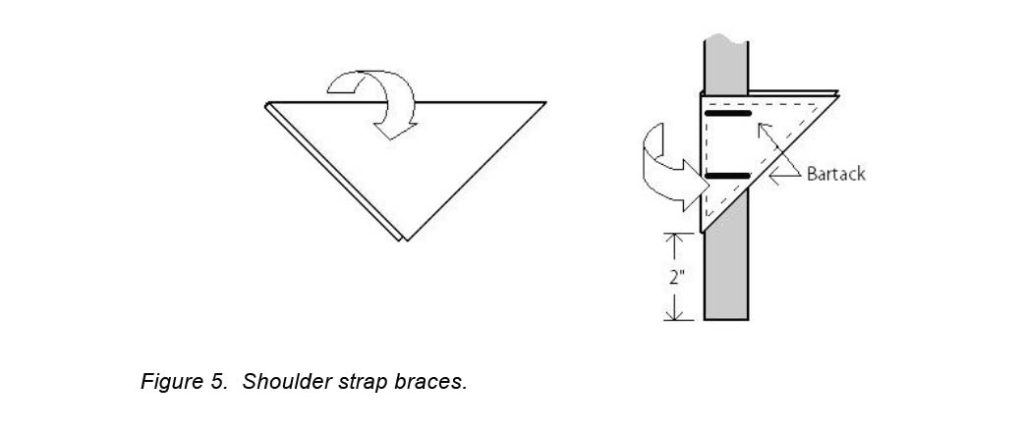
Figure 5. Shoulder strap braces.
Step 3: Waist Belts
3.1 Make 1/2″ slits in waist belts and linings where indicated in Figure 6.

Figure 6. Layout of waist belt.
3.2 Fold under (to the wrong side) between slits making a 5″ tab.
3.3 Sew 1/2″ hook and loop fasteners to wrong side of tabs, hook on the lining and loop on the waist belt.
3.4 Sew waist belts to lining, right sides together, leaving wide end (without hook and loop) open. Trim corners.
3.5 Turn waist belt right side out.
3.6 Topstitch around waist belts, except where hook and loop are attached.
3.7 Sew 18” piece of 1” webbing onto the closed end (small end) of one of the waist belts. Fold end over and bartack as shown in Figure 7. Repeat for other waist belt, making sure you end up with a left and a right with the webbing sewn on the outside, so it won’t rub against your waist.
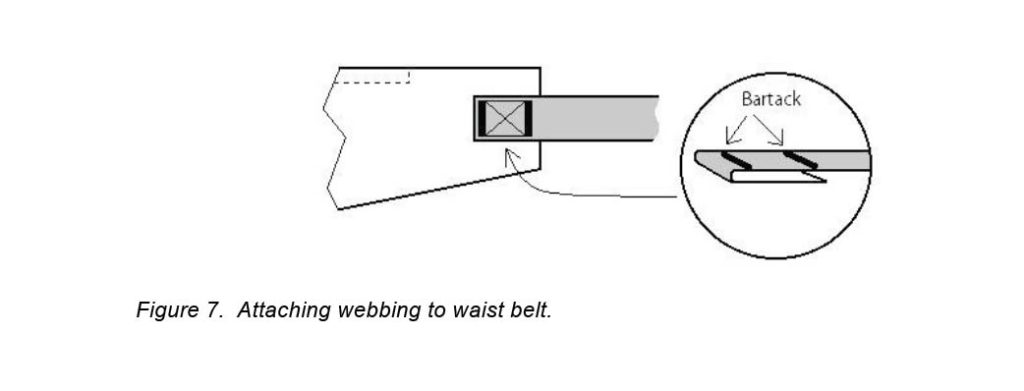
Figure 7. Attaching webbing to waist belt.
Step 4: Back (Oxford Cloth)
4.1 Haul Loop
4.4.1 Attach 10” piece of 1” webbing to the right side of the back, centered along the top. Sew as shown in Figure 8.
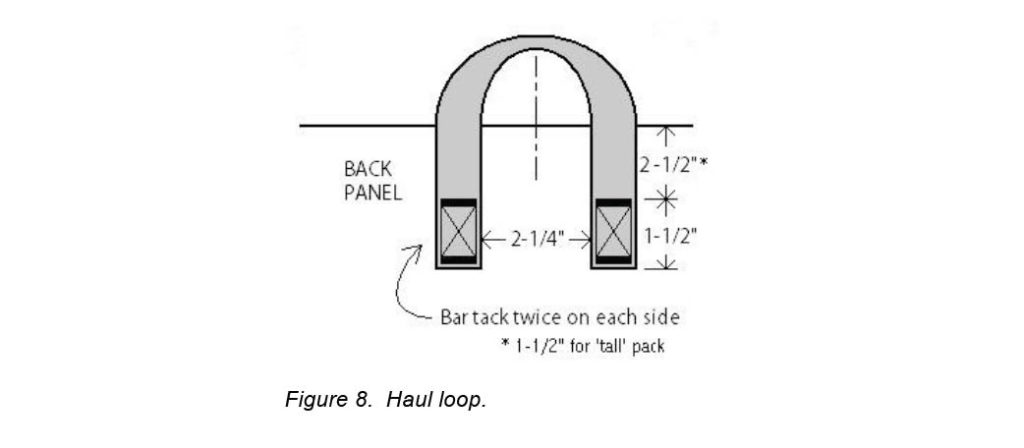
Figure 8. Haul loop.
4.2 Attaching Shoulder Strap Tops
Attach the shoulder strap tops, open ends, onto the right side of the back panel, as indicated on the pattern and Figure 9. On the right side of the back, lay the straps down so the ladderlocks are facing down, and the ends are curving away from the center. Edge stitch and do two short bartacks per strap as shown in Figure 9.
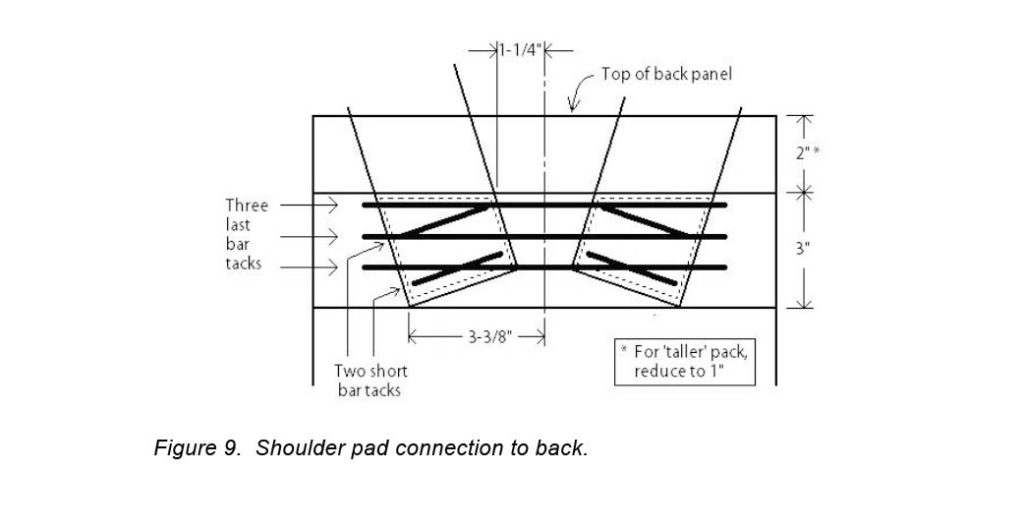
Figure 9. Shoulder pad connection to back.
4.3.3 Sew the shoulder strap cover onto the back panel, over the ends of the straps, positioned 2” from top as shown in Figure 9. Edge stitch and bar tack three times as shown in Figure 9.
4.3 Pad Holders
4.3.1 Sew the upper pad holder over the shoulder strap cover, positioning ¼” below the top edge of the shoulder strap cover. Pin to prevent from bunching up all at one end.
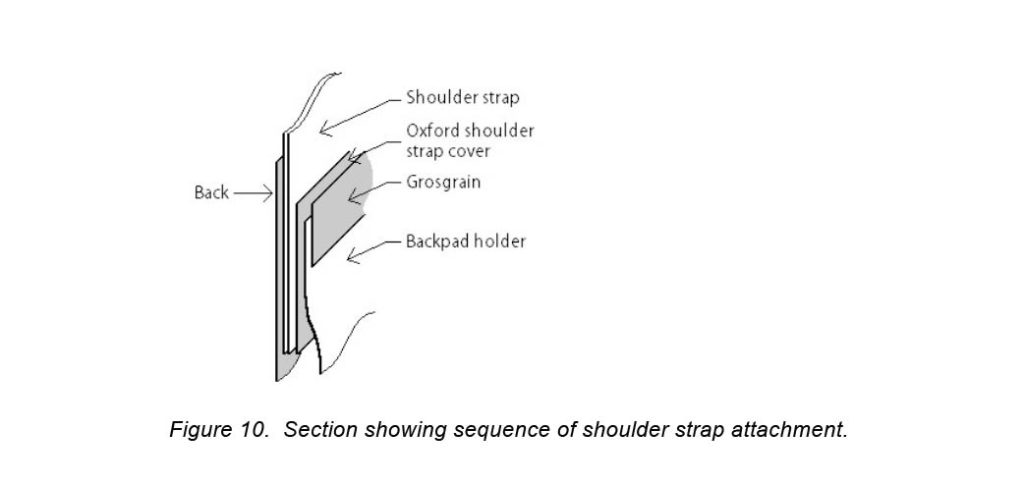
Figure 10. Section showing sequence of shoulder strap attachment.
4.3.2 Add 12” piece of Grosgrain ribbon, covering top edges of the shoulder strap cover and the pad holder. Stitch around all four sides of the Grosgrain.
4.3.3 Sew lower pad holder onto back panel in location shown on Figure 11. The spacing between pad holders will depend on the width of the Z-Rest pad. The pad is 20” wide when you buy it. I trim mine down to 15”. If you are planning on carrying more than 8 sections, it will be thicker when folded up, and you may want to add an extra inch or two between the holders. Pin the mesh so it doesn’t bunch up all at one end.
4.3.4 Cover the bottom edge of the bottom pad holder with the 16” piece of Grosgrain ribbon and stitch around all four sides of the ribbon.
4.3.5 Sew the edges of the pad holder onto the back panel with a 3/8” seam. Pin first so that the mesh doesn’t stretch as you are sewing.
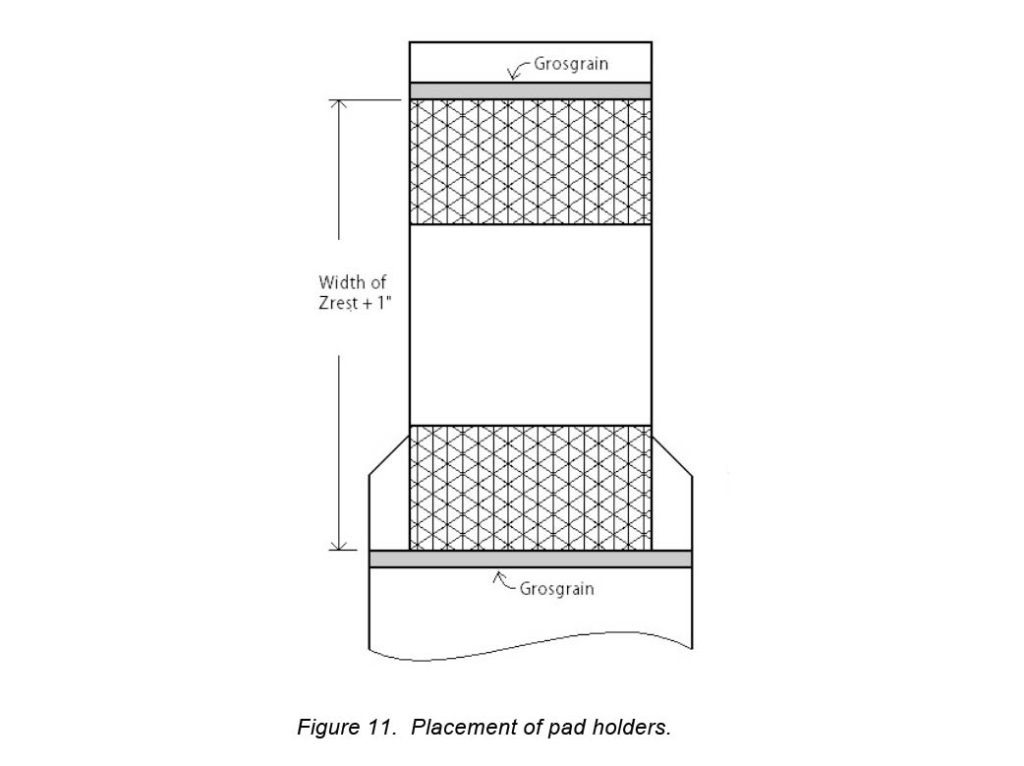
Figure 11. Placement of pad holders.
4.4 Attaching Shoulder Strap Bottoms and Lashing Straps
4.4.1 Sew the shoulder strap bottoms onto the back panel per Figure 12.
4.4.2 Sew the 4 – 3 ½” Grosgrain lashing straps onto the back panel as shown in Figure 12.
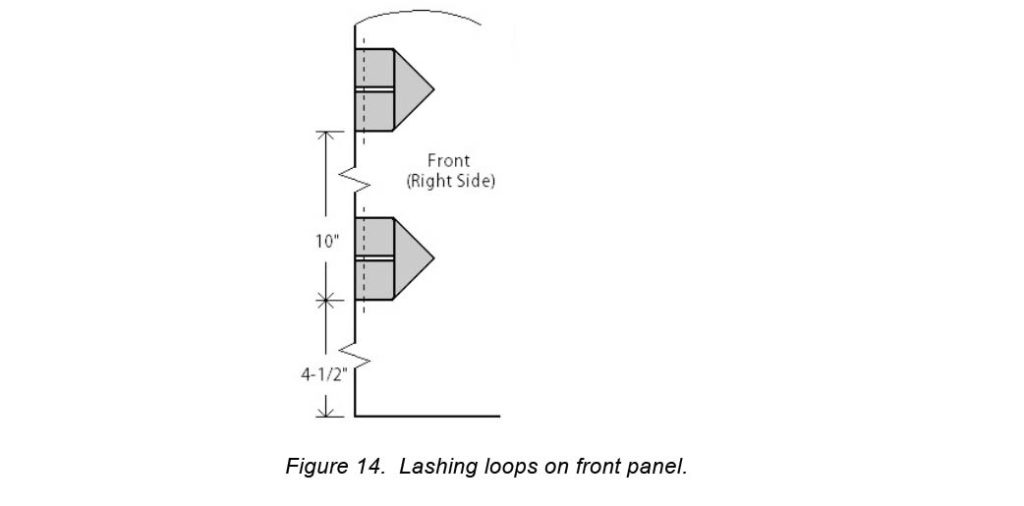
Figure 12. Placement of shoulder strap bottoms and lashing straps.
4.5 Attaching Waist Belts to Back Panel
4.5.1 Sew open ends of waist belts to back panel, using a 3/8” seam. Position as shown in
Figure 13.
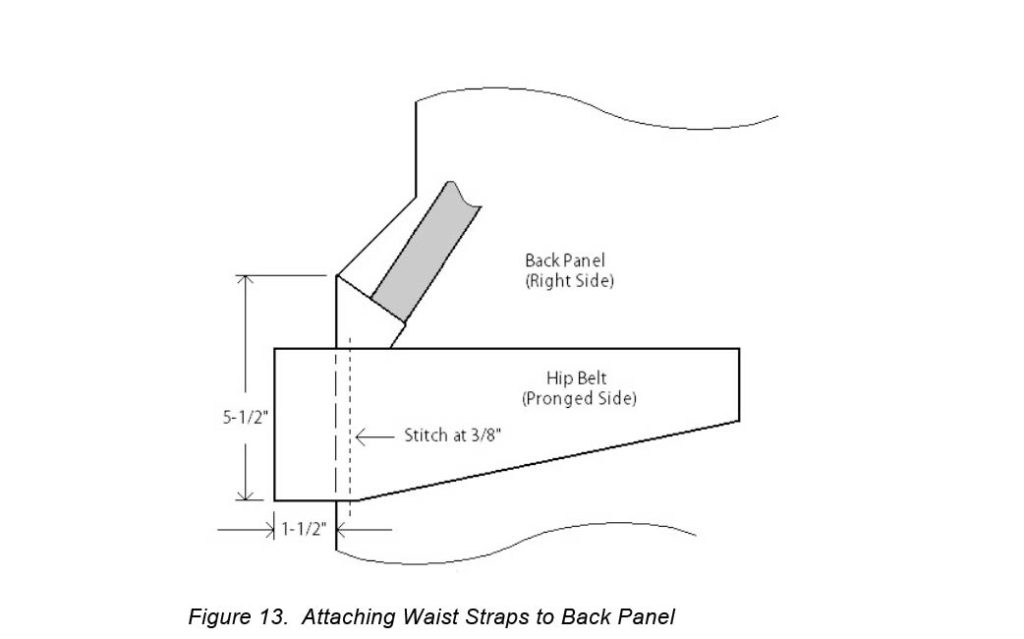
Figure 13. Attaching Waist Straps to Back Panel
Step 5: Front (Ripstop)
5.1 Lashing Loops
5.1.1 Sew 4 – 3½” Grosgrain lashing loops onto the front panel per Figure 14 with 3/8” seam.
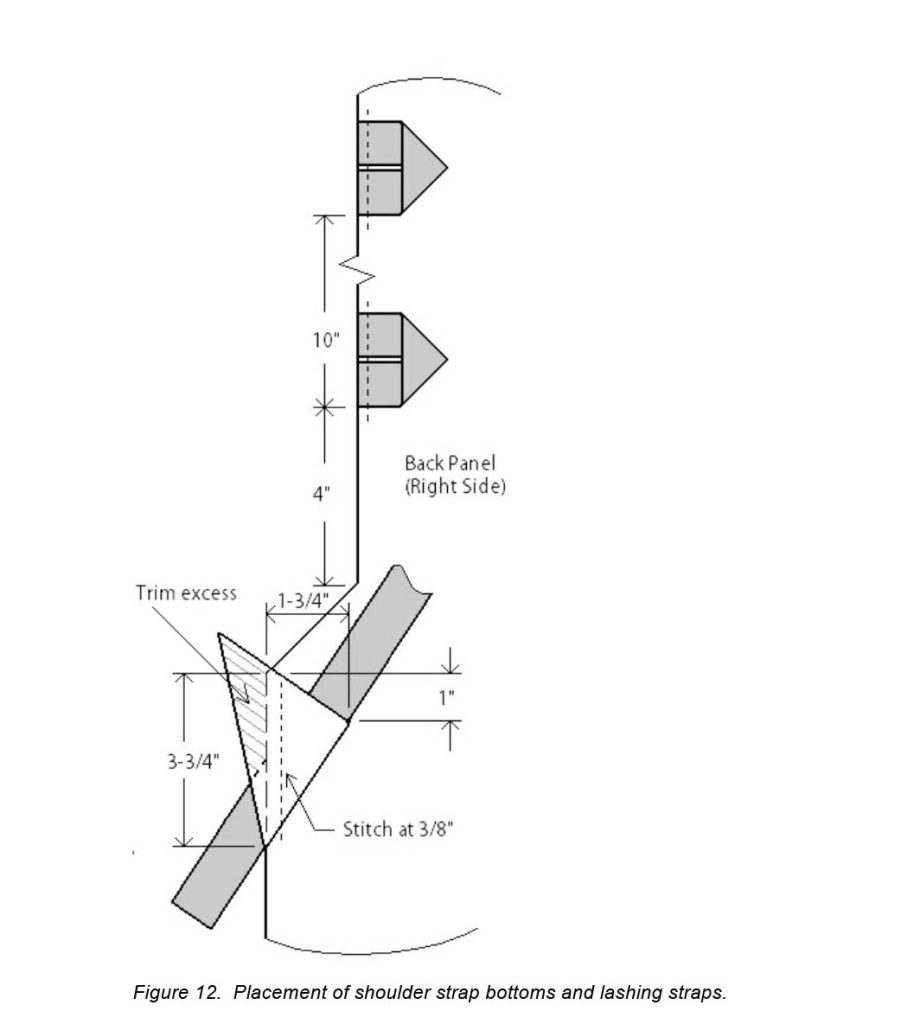
Figure 14. Lashing loops on front panel.
5.2 Front Pockets
5.2.1 Sew one of the ripstop edge pieces onto the top edge of the mesh pocket, right sides together. See Figure 15.
5.2.2 Fold to inside, line up ripstop edges, and stitch down, sewing over the seam you made in the last step. See Figure 15.

Figure 15. Top of pocket.
5.2.3 Thread a 16” piece of shock cord into the channel. Sew across one end and a tie a knot in the end of the cord, close to where it is sewn across.
5.2.4 Sew the pocket to the front panel. Line up so the bottom edges are even. Sew the sides first with 3/8” seam, being sure to catch the shock cord in the seam. You will need to tighten the cord to do this. After sewing over the cord, tie a knot in the end, close to the seam. When sewing the bottom of the pocket onto the bottom of the front panel, you will need to gather the pocket slightly, as it is wider than the front panel.
5.3 Assembly of Front Panel
5.3.1 Sew ripstop front bottom onto front panel, right sides together, as shown in Figure 16. The front pocket should be in between the two pieces. Double stitch.
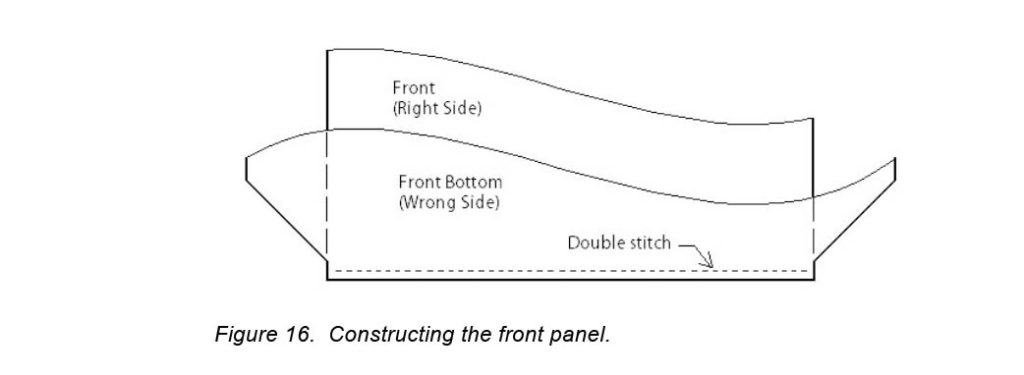
Figure 16. Constructing the front panel.
Step 6: Side Pockets
6.1 Sew bottom corners of side pockets together to form a dart in the pocket shape. Leave the last ½” open. Double stitch. See Figure 17.
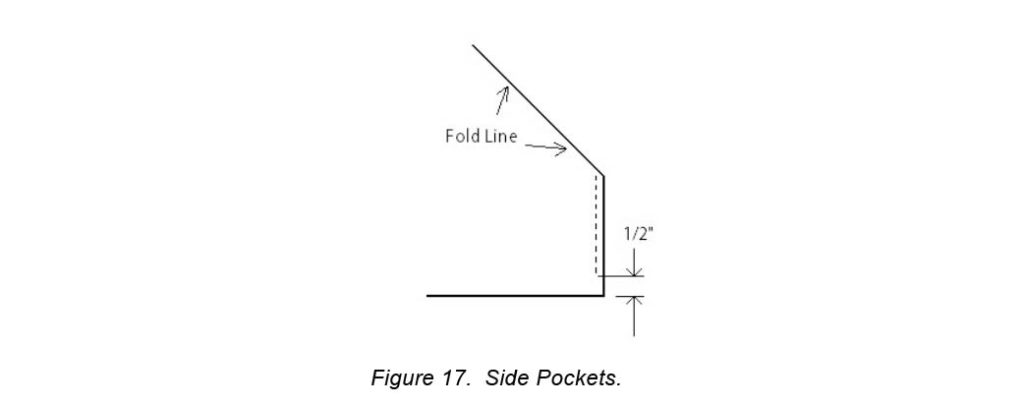
Figure 17. Side Pockets.
6.2 Attach ripstop pocket edging to top of pocket in same manner as for front pocket, as shown in Figure 15. Thread the 16” pieces of shock cord, sew one end and knot. Trim any excess (not too close to knot) and sear with flame.
6.3 Sew mesh pockets onto ripstop sides, bottom seam first. Be sure to tighten the cord to 9”, sew it into the seam, then knot the cord, trim and sear.
6.4 Sew the straight edge of the oxford bottom side piece onto the side, right sides together. Check to make sure you end up with a left and right side. Double stitch.
Step 7: Attaching the Sides, Front and Back
7.1 Sew the front to the sides, right sides together, beginning at the “angle point” where the width of the pack changes. Make sure the left side is on the left and the right side is on the right. Sew up both sides, matching pocket edges. Double stitch. Bartack over lashing loops in seam allowance.
7.2 Sew back panel to sides, right sides together. Double stitch. Bartack over lashing loops in seam allowance.
7.3 Sew the front and the back panels together where they join, and trim off any excess ripstop.
7.4 Reinforce ends of shoulder strap bottoms and waist belts to inside of oxford side bottoms. Flatten the back and the strap and belt, pulling them tight to make sure it’s flat, and stitch around edges of waist belt. Bartack twice as shown on Figure 18.
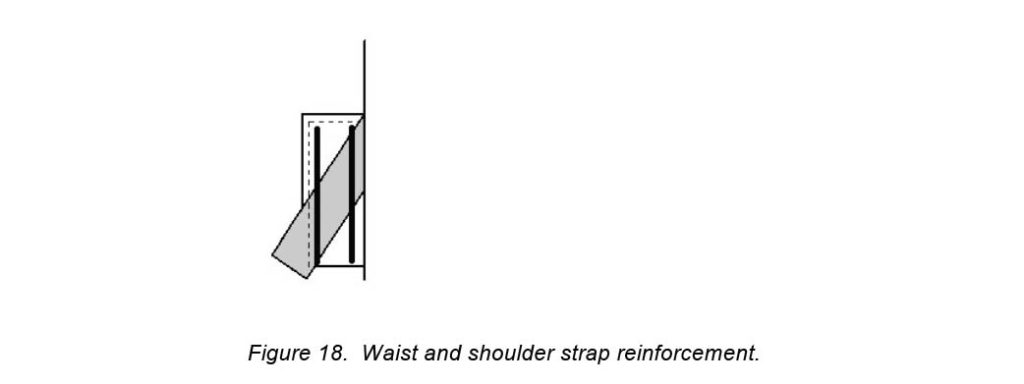
Figure 18. Waist and shoulder strap reinforcement.
Step 8: Collar (Ripstop)
8.1 Sew the center seam of the collar, right sides together. On the inside, stitch down the seam allowances on both sides of the seam. See Figure 19.

Figure 19. Collar.
8.2 Open the top 2” of the center seam. Bar tack at new end of seam per Figure 20.

Figure 20. Collar center seam.
8.3 Fold the top edge to the wrong side, forming a sleeve for the shock cord. Fold under ¼” and stitch down per Figure 21.

Figure 21. Collar sleeve for shock cord.
8.4 Thread 48” shock cord into sleeve and attach toggle. Press down on toggle until it “clicks” to activate it. Sear ends of shock cord and tie together in knot that won’t slip through the toggle.
Step 9: Finishing
9.1 Slide Closure
The slide closure is in response to people hiking where it often rains that wanted a little additional protection. While we recommend you continue to pack your clothes and sleeping bag within a trash compactor bag or similar protection from water, you may want to construct either the slide top closure or the optional roll-top closure to provide an additional measure of security.
9.1.1 Hem two opposite sides of the 14” square ripstop slide top.
9.1.2 Fold over and sew the other two sides to create sleeves.
9.1.3 Thread a 24” long piece of shock cord into each sleeve. Sew across the shock cord at one end of the sleeves so that 4” of shock cord is left out on that side. The shock cord protruding from the other end of the sleeve will be longer.
9.1.4 Tie the short shock cords onto the upper lash loops on the back panel of the pack. Tie the longer shock cords onto the lower lash loops on the front panel of the pack.
This configuration allows you to slide the top up and out of the way to access the inside of the pack. When closing the pack, first cinch up the drawcord, and pull it down through the bottom lashing loop. Use the toggle to “catch” against the loop and hold the top down with no need to tie a knot. Then slide the slide top down to cover the opening.
9.2 Thread 1” webbing through ladderlocks on shoulder strap tops. Fold over the ends of the webbing about ¾”, and sew near the folded edge. Fold so that the end is on the outside, which gives you something to grab when you tighten the straps.
9.3 Trim the excess off the waist belt straps. Make sure to allow enough for when you are wearing additional jackets. You may want to wait until you have used the pack for awhile. Sear the cut ends with a flame and fold over and sew similar to the shoulder straps.
9.4 Optional Roll-Top Closure
See the illustrations below for making the roll-top closure. For instructions on use, see the sequence under the photos section of www.gvpgear.com .

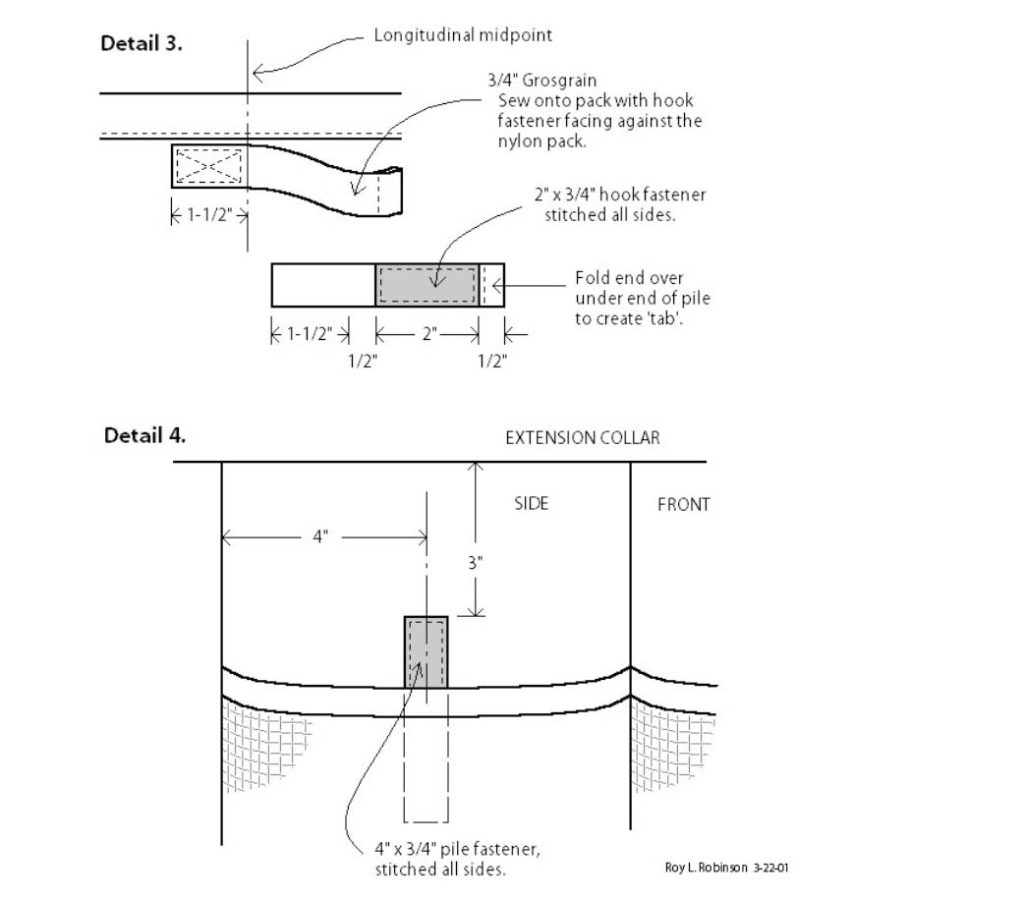
Tips for Use
Care
Your G4 pack is constructed of lightweight materials. One of the tradeoffs of designing with extremely lightweight materials is durability. The design and materials have been tested over hundreds of trail miles. The G4 will not last as long or endure the same abuse as other packs. With the best of care it may still need to be repaired or replaced after a few months on the trail. Each time you head our on a trip, check over your pack carefully and repair or reinforce any areas showing wear. The ripstop nylon is very susceptible to abrasion. If you put down the pack with the nylon ripstop on rocks, your pack will shred. Pay attention when you are ducking under barbed wire fences and squeezing between rocks or through prickly brush. If you do a lot of these activities, the G4 is not the pack for you.
Packing
The basic premise in the design of the G4 is using the lightest materials possible and utilizing packed items as part of the pack. The “frame” of the G4 is your sleeping pad. We use a Z-Rest cut down to six sections in length. The padding for shoulder and waist straps are sleeping socks and gloves/hat, using items that would normally just be weight in your pack when walking. For packing, sit on your pad and stow the sleeping bag in the bottom of the pack. Since the G4 seams are not sealed, we recommend using a trash compactor bag or mylar turkey roasting bag for protecting your sleeping bag and clothes. We recommend dispensing with the weight of a stuff sack and just stowing the bag directly into the trash compactor or mylar bag in the pack.
The bottom of the pack is expanded to provide area for your sleeping bag and minimize loss of loft from over-compression. Packing the sleeping bag on the bottom helps raise the center of gravity. When you take off your sleeping socks, stuff them into the shoulder straps for padding. You may be wearing your hat and gloves to start, and have nothing to put in the waist belt. However, if it is cold, you will be wearing your jacket, which provides padding. Next pack your clothes, also in the protective turkey or trash bag. Next put in your other gear and finally your food. Comfort is improved by keeping hard objects away from your back, but heavy items are best placed closer to the back to minimize the pull on the shoulders.
If you start out early in the morning, you may be wearing most of your clothes. Loading your pockets with food for the morning will allow you not to have to stop to remove food from your pack. When the day warms up and you stop to strip clothing, we recommend putting the clothing below the food, since the clothing is usually less dense, and packing the clothes below the food will raise the center of gravity. If your tarp/tent/ground cloth is damp, it can be placed in the large back pocket. Placing the wet tarp in the outside pocket will keep it away from your dry gear, and it may dry a little. The side pockets are designed to store water (the tall Platypus fits nicely), first aid kit and “ten essential” items that you want to have ready access to. Once your pack is packed, you can get up, fold up your pad, and slip it into the back of the pack. Under normal loads and in clear weather, fold the top of the extension collar over, and pull the shock cord through the webbing loop in the bottom center of the pack. You can either loop the shock cord back up and loop it over the toggle, or slide the toggle up snug against the bottom loop to hold the top. When carrying a full load after a large resupply or taking another hiker’s gear, just cinch up the toggle on the shock cord. For inclement weather, use either your slide top or roll-top closure. Keep in mind that the seams are not sealed. For dry weather use, we feel you will find that it is more convenient not to use the roll-top closure, though you may like the cleaner look.
When you pick up or take off your full pack, always use the haul loop. When setting it down, be sure that the pack is resting on the heavier Oxford material on the back and the bottom. Never sit or rest on a loaded pack.
Fit
For the best fit, we recommend loosening the shoulder straps and waist belt each time you take off the pack. When you put the pack on, fasten the waist belt, hike the pack up on your hips, tighten the waist belt then tighten the shoulder straps.
Personal Customizing
There are several things you may want to consider to personalize your pack. For more rainy climes, you might consider seam-sealing the inside seams. For 1.1 oz. ripstop, use a 50/50 mixture of silicon caulking and white gas, and paint it on. For the 2.2 oz. ripstop, use conventional seam sealer. If your hiking clothes don’t have a lot of pockets, you could order some lycra mesh and sew small pockets onto the shoulder or waist straps to carry small items that you want to have handy. To save weight, you should trim the waist belt to size. Be sure to take into account that you may be wearing additional layers, and don’t cut it too short. After cutting, seal the end with a flame, and sew back over on itself to prevent it from slipping through the buckle. Also in the interest of minimizing weight, you are encouraged to trim off straps you don’t use. If you only use a drinking tube on the right side, trim off the loops on the left side. If you don’t use a drinking tube or thumb loops, trim the loops off.
Available as Ready-Made
I recommend sewing your own gear, because you have the opportunity to customize it specifically to your style and needs. That is why I starting sewing packs. The packs I design are distinctly suited to my backpacking style, and most other people will probably want to change them a little (or a lot). However, I have received enough requests to purchase ready-made packs that I have made arrangements to produce limited numbers of the G4 pack for purchase. The packs are available through our website at www.gvpgear.com . You can buy either an off-the-shelf G4 made according to these plans, or order a semi-custom with modified pad holder dimensions, your choice of color, etc.